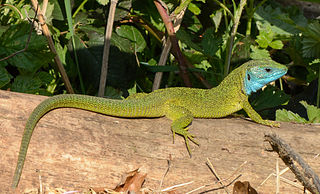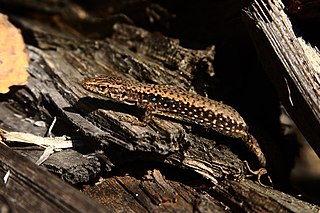
Lacerta is a genus of lizards of the family Lacertidae.

The European green lizard is a large lizard distributed across European midlatitudes from Slovenia and eastern Austria to as far east as the Black Sea coasts of Ukraine and Turkey. It is often seen sunning on rocks or lawns, or sheltering amongst bushes.

Timon princeps, commonly called the Siirt lizard or the Zagrosian lizard, is a species of lizard in the family Lacertidae. The species is endemic to Western Asia.
Darevskia alpina is a species of lizard in the family Lacertidae. It is found in the Greater Caucasus in Georgia and Russia.
Darevskia clarkorum is a species of lizard in the family Lacertidae.
Darevskia chlorogaster, the greenbelly lizard, is a lizard species in the genus Darevskia. It is found in Azerbaijan and Iran.
Iranolacerta brandtii, also known as Brandt's Persian lizard, is a species of lizard found in Iran, Azerbaijan, and Turkey. It is named for Johann Friedrich von Brandt, a German zoologist, surgeon, pharmacologist, and botanist.
Darevskia brauneri, Brauner's rock lizard, is a lizard species in the genus Darevskia. It is found in Georgia and Russia.

Darevskia caucasica is a lizard species in the genus Darevskia. It is found in Russia, Georgia and Azerbaijan.
Darevskia daghestanica is a species of lizard in the family Lacertidae. It is found in Georgia, Azerbaijan, and Russia.
Darevskia dryada, the Charnali lizard, is a lizard species in the genus Darevskia. It is found in Georgia and Turkey.

Darevskia mixta is a lizard species in the genus Darevskia. It is endemic to Georgia.
Darevskia parvula, the red-bellied lizard, is a lizard species in the genus Darevskia. It is found in Georgia and Turkey.

Darevskia portschinskii is a species of lizard in the family Lacertidae. The species is endemic to the South Caucasus region of Eurasia. There are two recognized subspecies.

Darevskia praticola, the meadow lizard, is a lizard species in the genus Darevskia. It is found in Georgia, Russia, Iran, Serbia, Bulgaria, Greece, Azerbaijan, Armenia, and Turkey.

Darevskia raddei, known commonly as the Azerbaijan lizard, is a species of lizard in the family Lacertidae. The species is endemic to Eurasia. There are four subspecies.
Darevskia saxicola is a lizard species in the genus Darevskia. It is found in Georgia, Russia, and Turkey.
Darevskia uzzelli is a lizard species in the genus Darevskia. It is endemic to Turkey.

Darevskia valentini, the Caucasian rock lizard or Valentin's lizard, is a lizard species in the genus Darevskia. It is found in Georgia, Armenia, Iran, and Turkey.

Lacerta media is a species of lizard in the family Lacertidae. It is found in Georgia, Armenia, Azerbaijan, Iran, Turkey, Israel, Jordan, Syria, Lebanon and Russia.











